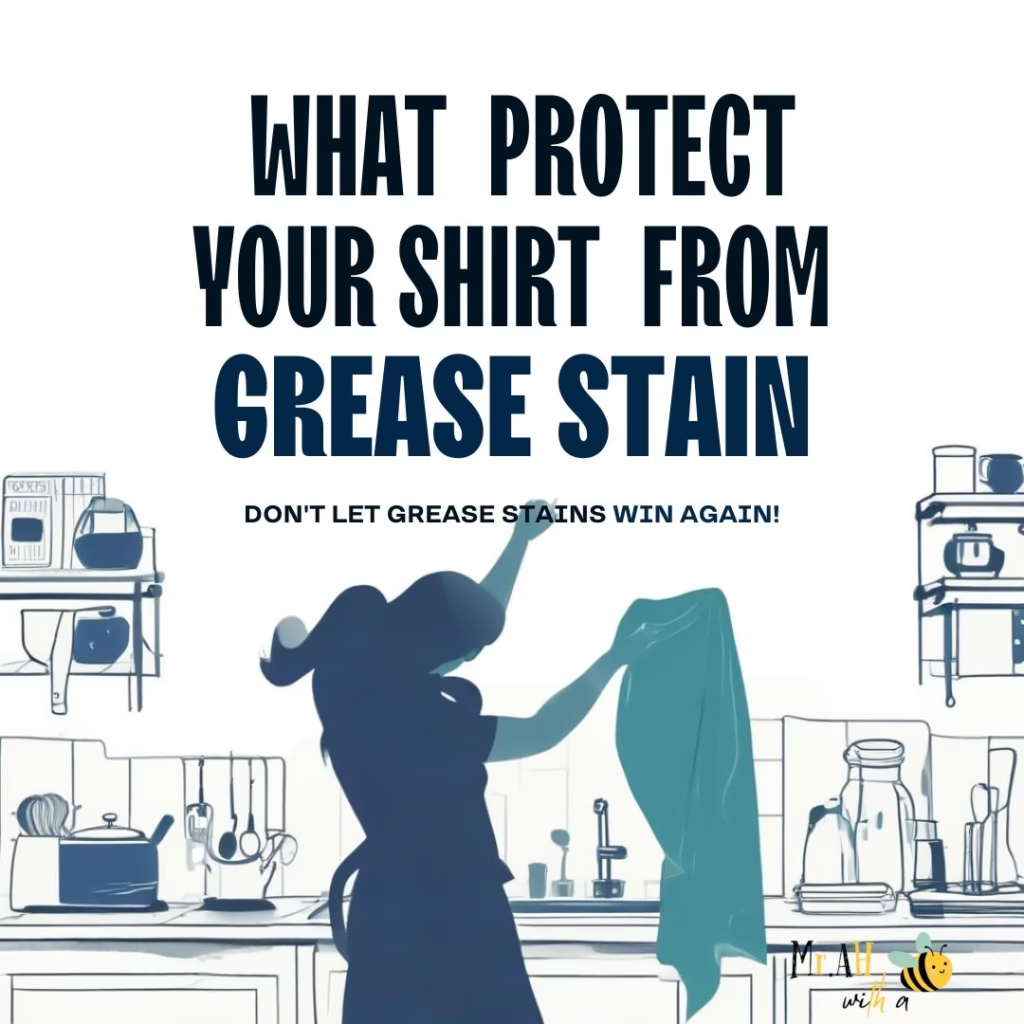Grease stains are a common nuisance, especially during meals or while working in oily environments. Preventing these stains and knowing how to treat them effectively can save your favorite shirts and reduce frustration. If you’re wondering what might protect your shirt from a grease stain, and struggling with stubborn grease stains? Don’t worry—if they’re on cotton, there’s a solution! While acting quickly increases your chances of success, it’s still possible to remove stains even if they’ve already set. So roll up your sleeves and tackle those greasy marks with confidence! In this guide, we’ll explore practical strategies for keeping grease stains at bay.
Understanding Grease Stains
What Causes Grease Stains?
Grease stains often originate from oily foods, cooking oils, and industrial lubricants. When these substances come into contact with fabric, they can adhere to the fibers of your shirt, creating a stubborn mark that is difficult to remove. The oily nature of grease allows it to penetrate deep into the fabric, making it challenging for standard washing methods to eliminate the stain. Understanding the sources of these stains can help you take preventive measures and act quickly when they occur, ensuring your clothing stays looking its best.
Why Are Grease Stains Difficult to Remove?
Grease can seep deeply into fabric fibers and does not dissolve easily in water. This property makes grease stains particularly stubborn. That’s why prompt treatment is essential; acting quickly can significantly improve your chances of successfully removing the stain before it has a chance to set. The longer the grease remains on the fabric, the more difficult it becomes to eliminate, as it bonds with the fibers. By addressing the stain immediately, you can enhance the effectiveness of your cleaning efforts and preserve the integrity of your clothing. Remember, the sooner you treat grease stains, the better your results will be!
Prevention Strategies
When it comes to keeping your clothing in top condition, understanding what might protect your shirt from a grease stain is essential. Implementing preventive strategies can help you avoid stubborn stains caused by cooking and dining. Here are effective tips to safeguard your garments and maintain their pristine appearance.
Protective Clothing
To safeguard your garments while cooking or handling greasy items, consider wearing aprons or protective overcoats. These layers act as a barrier between your clothing and potential stains. Additionally, choose shirts made from stain-resistant fabrics specifically designed to repel grease and liquids. These materials can help keep your clothes looking fresh and clean, even in messy situations.
Fabric Treatments
Another effective strategy is to apply stain repellents or water-resistant sprays to your shirts. These treatments create a protective layer that helps prevent grease and other substances from adhering to the fabric. Be sure to follow the application instructions carefully to ensure optimal results and maintain the effectiveness of the treatment.
Choosing the Right Fabrics
When selecting clothing, consider fabrics like polyester and nylon, which are less likely to absorb grease compared to traditional cotton. These synthetic materials can provide better resistance to stains. Additionally, look for clothing labeled as “stain-resistant” while shopping. This designation indicates that the fabric has been treated to resist stains, giving you an extra layer of protection against spills and splatters. By being mindful of your clothing choices and taking preventive measures, you can significantly reduce the risk of grease stains and keep your wardrobe looking its best.
Immediate Actions to Take
Blotting the Stain
The first step in addressing a grease stain is to gently blot the area with a paper towel or a clean cloth. This helps absorb excess grease without spreading it further. Be careful to avoid rubbing the stain, as this can push the grease deeper into the fabric fibers, making it more difficult to remove.
Using Stain Removers
Next, apply a specialized grease-fighting stain remover directly to the stained area. A stain remover is a product specifically formulated to eliminate stains or dirt marks from various surfaces, such as clothing, carpets, and other materials. It typically functions by chemically breaking down the stain molecules, making them easier to wash away and restore the original appearance of the fabric or surface. After applying the stain remover, it’s important to wash the shirt promptly in warm water, which aids in lifting the stain. Common stain removers include enzyme-based detergents, bleach, vinegar, and specialized cleaning solutions, all tailored to address different types of stains. By acting quickly and using the right products, you can significantly increase the chances of completely removing the grease stain.
Dish soap
Liquid dish soap is an excellent option for tackling grease stains, as it is specifically designed to break down and dissolve oily substances. Its powerful degreasing properties make it highly effective for removing grease from fabrics. To use dish soap, simply apply a small amount directly to the stained area and gently work it into the fabric with your fingers or a soft cloth. Allow it to sit for a few minutes to give the soap time to penetrate the stain. Then, rinse thoroughly with warm water before laundering as usual. This method not only helps eliminate the stain but also leaves your clothing smelling fresh.
WD-40
WD-40 can be an effective solution for removing grease stains from fabrics due to its lubricating properties. To use it, first test a small, inconspicuous area of the fabric to ensure there’s no discoloration. Spray a small amount of WD-40 directly onto the grease stain and let it sit for about 5-10 minutes to help break down the grease. Then, gently blot the area with a clean cloth or paper towel to absorb the grease, taking care not to rub, as this may spread the stain. Launder the garment as usual in the hottest water safe for the fabric, and be sure to check that the stain is completely gone before drying. Remember to use WD-40 in a well-ventilated area and avoid mixing it with other cleaning products. While effective, it’s best suited for sturdy fabrics, so use caution on delicate materials like silk or wool.
Home Remedies for Grease Stains
Common Household Items
Baking Soda
This versatile ingredient can be used to tackle grease stains effectively. Simply sprinkle baking soda directly onto the stain and allow it to sit for a while. The baking soda will absorb the grease, and once it has done its job, you can gently brush off the residue.
Dish Soap
Known for its grease-fighting abilities, dish soap can be a powerful ally in stain removal. Apply a small amount of dish soap directly to the stained area and gently rub it in. After a few minutes, rinse the fabric thoroughly with water before washing it as usual.
Cornstarch
Cornstarch is another effective alternative to baking soda. It can be sprinkled on the stain to absorb grease quickly. After letting it sit for a bit, simply brush off the cornstarch to remove the stain.
When to Seek Professional Help
If the stain remains stubborn even after several attempts to remove it, it may be time to consult a professional. Taking the shirt to a dry cleaner can be a wise decision, as they have access to specialized solvents and equipment designed to tackle tough grease stains. Professionals are trained to handle a variety of fabrics and stains, ensuring that your garment is treated safely and effectively.
Step-by-step guide to get rid of grease stains
When dealing with grease stains, knowing what might protect your shirt from a grease stain is essential for effective cleaning. This guide outlines practical steps to treat both fresh and set stains, ensuring your clothing remains in great condition while minimizing frustration during the stain-removal process.
- Prepare the Clothing: Lay the garment flat on a clean surface.
- Protect the Underneath: Place cardboard or an old towel under the stain to catch excess liquid.
- Treat the Stain: For fresh stains, sprinkle baking soda on the grease. For set stains, apply dish soap. Let it sit for 5-10 minutes.
- Scrub the Stain: Gently scrub with a toothbrush, ensuring it penetrates the fabric. If the stain is fresh, the baking soda will change color. Remove the first layer and reapply as needed.
- Repeat as Necessary: Continue until the baking soda stops turning brown.
- Add Dish Detergent: If the stain persists, add dish detergent for fresh stains or sprinkle baking soda over the detergent for older stains.
- Scrub Again: Use the toothbrush to work the new mixture into the fabric.
- Let It Set: Allow the mixture to sit for 10-15 minutes.
- Wash the Garment: Launder as usual in the hottest safe water for the fabric, noting that some cotton may shrink.
- Check the Stain: Before drying, ensure the stain is completely gone.
Conclusion
In conclusion, grease stains can be a frustrating challenge, especially from meals or oily work environments. By understanding what might protect your shirt from a grease stain and employing effective treatment methods, you can save your favorite garments from permanent damage. Timely action is key: whether the stain is fresh or set, there are numerous strategies available to tackle it. With the right techniques and household items, you can confidently address grease stains and maintain the quality of your clothing. Embrace these practical solutions and keep your wardrobe looking its best!
FAQs
- What might protect your shirt from a grease stain?
Wearing stain-resistant clothing or using a protective apron can help prevent grease stains. - How can I treat a grease stain immediately?
Blot the stain with a paper towel and apply dish soap or a stain remover before washing. - What household items can remove grease stains?
Baking soda, cornstarch, and dish soap are effective for treating grease stains. - Are there fabrics that resist grease stains better?
Polyester and nylon are more grease-resistant than cotton. - How do stain repellents work?
Stain repellents form a protective layer on fabric that prevents grease from penetrating. - Can I remove an old grease stain?
Yes, use a heavy-duty stain remover or take the shirt to a professional cleaner. - What’s the best way to store clothes to prevent stains?
Store clean clothes in a dry, cool place to avoid accidental exposure to grease. - Is baking soda safe for all fabrics?
Yes, baking soda is gentle and works well on most fabrics. - What should I avoid doing with a fresh grease stain?
Avoid rubbing the stain, as it can push the grease deeper into the fabric. - How can I make my shirts more stain-resistant?
Apply a fabric spray or choose shirts made with pre-treated, stain-resistant materials.
If you like reading this post you may also like
Thanks for reading, for more interesting articles, visit our homepage.







